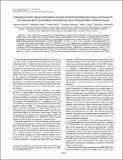| dc.contributor.author | Yolanda M Brooks 1, Shalean M Collins 2 3, Patrick Mbullo 4 2, Godfred O Boateng , Sera L Young , Ruth E Richardson | |
| dc.date.accessioned | 2022-01-28T13:32:10Z | |
| dc.date.available | 2022-01-28T13:32:10Z | |
| dc.date.issued | 2017 | |
| dc.identifier.issn | : 1476-1645 | |
| dc.identifier.uri | https://repository.maseno.ac.ke/handle/123456789/4741 | |
| dc.description | The American Society of Tropical Medicine and Hygiene | en_US |
| dc.description.abstract | We compared the concentrations of Escherichia coli quantified with Colilert™ and the compartment bag test (CBT) in the source water and household stored drinking water (SDW) of 35 households in western Kenya. We also investigated the associations of the perceptions of organoleptic properties and overall quality with ≥ 1 MPN/100 mL E. coli in SDW. Participants who rated the taste or smell of their SDW "< 5" on a 1 = "poor" to 5 = "excellent" Likert scale were 8.71 or 7.04 times more likely, respectively, to have ≥ 1 MPN/100 mL E. coli. Organoleptic properties are innate, albeit imperfect, indicators of fecal pollution in water. Within their shared quantification range, concentrations of E. coli enumerated with Colilert and CBT were similar and had a significant correlation coefficient, 0.896 (95% confidence interval = 0.691-1.101). The methods had moderate agreement within the World Health Organization's health risk levels (Cohen's Kappa coefficient = 0.640). In low-resource settings, CBT provides comparable assessments of E. coli concentrations to Colilert. | en_US |
| dc.publisher | National library of medicine | en_US |
| dc.title | Evaluating Human Sensory Perceptions and the Compartment Bag Test Assays as Proxies for the Presence and Concentration of Escherichia coli in Drinking Water in Western Kenya | en_US |
| dc.type | Article | en_US |

